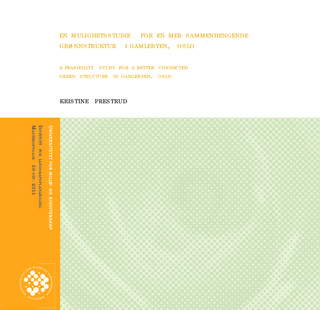| dc.description.abstract | Målet med oppgaven er å finne frem til løninger som kan skape bedre sammenkobling av grønnstrukturen i Gamlebyen – et sentrumsnært
område i Oslo med god tilgang på grøntområder, men som samtidig preges av oppsplittende infrastruktur.
Oppgaven består av en innledende del, en
analysedel og en avsluttende mulighetsstudie:
I innledningsdelen gjøres det først rede
for oppgavens problemstilling, oppbygging
og metode, før det gis en introduksjon til
oppgaveområdet, med særlig vekt på historisk utvikling og pågående utviklingsprosesser. I analysedelen undersøkes dagens situasjon med fokus på grønnstruktur og temaer som i stor grad virker inn på denne. I den avsluttende mulighetsstudien jobbes det ut fra en strategibasert fremgangsmåte.
Hovedfunnene fra analysedelen danner her
grunnlag for strategiene, hvorav den første
tar utgangspunkt i gjenåpning elveløp som
i dag ledes lukket gjennom området, den
andre ser på realismen i etablering av lokk over jernbanen, mens den tredje undersøker gatenettverkets potensial som grønn forbindelse. En vurdering og sammenligning av strategiene
konkluderer med at samtlige har betydelige
bidrag å komme med i forhold til målet om en mer sammenhengende grønnstruktur, men også betydelige svakheter, og at en kombinasjon av de tre derfor vil gi den høyeste graden av måloppnåelse. The aim of this thesis is to find solutions that
may create a better connected green structure in “Gamlebyen” – a district close by the city center of Oslo, with good access to green spaces, but which also is characterized by infrastructure that
divides up the area. The thesis consists of an introductory part, an analysis part and a final feasibility study:
In the introduction part the thesis’ subject,
structure and applied method will be presented. Then an introduction to “Gamlebyen” is given with a particular focus on the historical development and the ongoing development processes.
In the analysis part the current situation is
examined, focusing on the green structures and factors that in a great extent affect them. The final feasibility study is based on a strategic approach. The main findings from the analysis part form the basis for the strategies. The first strategy looks to the reopening of the riverbeds which are currently being lead through pipes in
the area, whereas the second strategy deals
with whether or not an establishment of “lids“ over the railway areas is a realistic possibility. Lastly, the third strategy examines the street network’s potential of constituting a green area connection.
An evaluation and comparison of the different strategies will prove that all three give important contributions to secure a more linked green structure, but that they all show significant weaknesses. Consequently, a combination of the
three strategies will provide the highest level of achievement. | no_NO |
